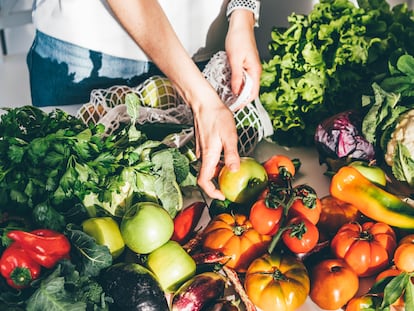Marketing and the food industry: Do we know what we’re buying?
Many of the so-called homemade, vegan or protein foods are, in reality, processed and ultra-processed products that provide no extra nutritional value

A brief walk through the supermarket is enough to realize how most processed and ultra-processed products created by the food industry are aimed at a specific public. Our eyes gravitate towards those that describe themselves as “homemade,” an empty label that adds no extra value, as much as they would have us believe that they were prepared with utmost care by some wonderful, grandma-like cook in a big clay cooking pot, far from anything remotely industrial. That is not the case. It is a mere sales tactic, and that tomato sauce is as processed as any brand name that pops into your head.
In addition, the entire industry is veering towards the vegetable realm, as more and more consumers opt for this type of diet. For this reason, meat and dairy brands have started to join this very welcome trend, as well as the generic supermarket brands. These products usually come in green packaging that boast about their vegetable content; but does being vegetable make it healthy? The short answer is no. You have to read the ingredients and discard almost by default the products that imitate omnivorous options with little nutritional value, such as sausages, chicken nuggets and fish sticks. The green color is also used to try to convey an idea of “health” and allude to the fact that it is eco-friendly and sustainable — but is quinoa sustainable where you live? Probably not, in which case it would entail a significant carbon footprint and, in turn, an increase in the price of this product where it is a basic cereal, as in Peru.
Another fad that has flooded supermarket shelves is that of high-protein products; you can find yogurts, dairy desserts, vegetable drinks, shakes with a higher content of protein, protein bread and more. But do we really need these products? Do we even know what those 16 grams of protein that those yogurts offer mean? Are we aware of our protein consumption, so as to look for an extra measure? Where does so much concern about protein come from, anyway? From sports nutrition and hyperproteic diets; protein is something like the cool macronutrient, it is necessary, satiating and has an acceptable caloric content, not like fat and carbs, which are loaded with calories by Satan himself.
The truth is that the West does not exactly suffer from a protein deficit; if there is something that we eat in abundance, it is precisely protein, in the form of meat, fish, eggs, dairy products, cheeses and more. Other regions do have a protein deficit. Nutrition is also subject to fads, and if fat used to be the enemy to avoid, almost regardless of its origin (the trans fat in a bread roll cannot be compared to the vegetable fat in some nuts), later the focus shifted to sugar. The madness has reached such Dantesque proportions that we have nutritionists and influencers saying things like fruits and vegetables are bad for the liver or that we must drink vinegar before meals to lower blood sugar.
Going back to yogurt, a natural one provides about 10 grams of protein, and the Icelandic yogurt Skyr, which has been available for some time now, has about 14 grams. As you can see, there’s nothing new under the sun.
High-protein products tend to come in black because they are more linked to sports nutrition and, in general, targeted at men (of course, strength is a guy thing). Without a doubt, my favorites are those that come in pink hues, those products for women that, more than nourish us, want to tell us what to do with our bodies. I’m not making any of this up; it is a marketing strategy. They link the meaning of pink — innocence, sweetness, femininity — with products that are usually aimed at women. In the pink spectrum I see two clear lines: one aimed at weight loss and problem areas of our bodies, and another at menopause.
In the first subgroup we can find everything from sugary bars that can substitute a whole meal and infusions to relieve heavy legs or regulate intestinal transit (and in the process reduce our belly) to fat-burning cookies and pink condensed milk (the same as the regular one, but made with skim milk, God forbid a woman would consume a full-fat dairy product). These products make it very clear that women’s nutrition is a means to change their body, with esthetics always coming before health. In truth, most of these products are unhealthy.
In the second line of the pink spectrum, they sell you all kinds of products — but now enriched in calcium, omega-3 and more. It seems funny to me, because in our society women become invisible after reaching a certain age because supposedly we are no longer attractive, but the industry lets us eat fat in the form of omega-3 and cares about our bones, our cholesterol and our overall health. Even if, in our fertile years, a couple of bars or a shake were more than enough.
Sign up for our weekly newsletter to get more English-language news coverage from EL PAÍS USA Edition
Tu suscripción se está usando en otro dispositivo
¿Quieres añadir otro usuario a tu suscripción?
Si continúas leyendo en este dispositivo, no se podrá leer en el otro.
FlechaTu suscripción se está usando en otro dispositivo y solo puedes acceder a EL PAÍS desde un dispositivo a la vez.
Si quieres compartir tu cuenta, cambia tu suscripción a la modalidad Premium, así podrás añadir otro usuario. Cada uno accederá con su propia cuenta de email, lo que os permitirá personalizar vuestra experiencia en EL PAÍS.
¿Tienes una suscripción de empresa? Accede aquí para contratar más cuentas.
En el caso de no saber quién está usando tu cuenta, te recomendamos cambiar tu contraseña aquí.
Si decides continuar compartiendo tu cuenta, este mensaje se mostrará en tu dispositivo y en el de la otra persona que está usando tu cuenta de forma indefinida, afectando a tu experiencia de lectura. Puedes consultar aquí los términos y condiciones de la suscripción digital.
More information
Últimas noticias
Most viewed
- Oona Chaplin: ‘I told James Cameron that I was living in a treehouse and starting a permaculture project with a friend’
- Reinhard Genzel, Nobel laureate in physics: ‘One-minute videos will never give you the truth’
- Sinaloa Cartel war is taking its toll on Los Chapitos
- Why the price of coffee has skyrocketed: from Brazilian plantations to specialty coffee houses
- Silver prices are going crazy: This is what’s fueling the rally











































